
Satellite images trigger payouts for Kenyan farmers in grip of drought
Innovative insurance scheme gives a lifeline to vulnerable pastoralists, as three years of poor rains kill thousands of livestock across northern Kenya
The Kenyangovernment is scaling up an innovative livestock insurance programme that uses satellite imagery of drought-hit areas to offer a safety net to vulnerable farmers. TheKenyaLivestock Insurance Programme (Klip) monitors forage conditions throughout the two annual rainy seasons, triggering payouts to pastoralists when vegetation dies back to critical levels.
The payments are designed to enable families that depend on livestock to purchase animal feed to keep their herd alive.
The scheme is paid for by the Kenyan government with development funding from the World Bank. Currently, the free insurance arrangement covers 14,000 farmers in six counties and is due to be extended to a further 10,000 in October, with hopes to cover 100,000 households by 2020. Similar programmes operate in Mexico, India, and China, but the public-private partnership is the first of its kind in Africa; Ethiopia is considering investing in a parallel scheme.
In the largest payout yet, in February £1.7m was paid to 12,000 pastoralists – an average of nearly £140 per household – to compensate forlast season’s drought, which caused the worst forage scarcity in Kenya for 16 years. With April’s rainy season starting late and predicted to be poor, the Klip programme could bring crucial relief to thousands of families on the brink of hunger.
The programme is modelled on a commercial scheme, the Index-Based Livestock Insurance programme, which was found to have increased milk productivity and reduced indicators of malnutrition for those who had it.
It is also thought to be cheaper to scale up than alternative drought management strategies, such as unconditional cash payments to farmers.
Kenyan economist Dr Andrew Mude devised the programme, winning the 2016 Norman Borlaug Award for his work. Raised in Marsabit, an arid county in northern Kenya where 92% live below the poverty line, Mude says he recognised the "loss of dignity” caused by livestock deaths during cyclical droughts.
"There’s a growing recognition that we need to think a bit more proactively and effectively about how we handle drought. This idea of always acting reactively – to request international support – is being considered as ineffective,” he says.
After three years of poor rains, swaths of the country have had their grazing pasture scorched, leaving animals and humans desperate. Government and humanitarian agencies estimate average livestock losses of 40%-60% in Kenya’s worst-hit north-east and coastal areas. In some places, the figure is as high as 80%.
Across the red plains of Marsabit county, more than 500km north of Nairobi, some communities are reaching breaking point. In Balesa, an assortment of makeshift dwellings where the smell of rotting carcasses hangs in the stifling heat, village elders say 200,000 animals have died since October.
"It is a disaster,” says Bonaya Urthe, a schoolteacher and herder who has lost 460 of his 500 goats. "We expect worse. Because animals are dying at this rate, it means that human death is also near.”
Since livestock acts as both the income and savings account for pastoralists, its dramatic decline has a direct impact on hunger. After last season’s poor rainfall devastated grazing pasture, the number of people needing food relief soaredfrom 1.3 million in August 2016 to 2.6 million in February. With poor rains predicted again this spring, the UN projected in March that this figure would reach4 millionby this month.
Though the entire Horn of Africa ispraying for rain, its arrival can be problematic. Animals are so weak and prone to pneumonia that flash downpours in a sub-county of Marsabit, the first of the season, killed 5,000 goats in just two days, according to local authorities.
Kenya is not amongthe four countries experiencing famine or on the brink of catastrophe, largely because its government detected the drought early and has spent nearly £1m so far mitigating its impact.
But the problem is increasingly beyond the government’s capacity – especially given the distraction of theelections in August– andthe UN has appealed for $166m (£132m) in aid to support vulnerable familiesbefore it is too late.
Near the Ethiopian border, residents of Dabele village say they have lost 40% of their livestock. The emaciated surviving animals have long stopped producing milk and have scant value at market. Some herders are feeding them cardboard soaked in water just to fill their bellies.

"It’s the worst drought we’ve ever seen,” says Hussain Fofle, conferring with tribal elders who watch over the village well. Their presence helps prevent conflict, since the exhaustion of neighbouring water sources has forced pastoralists to travel from miles around – often across the Ethiopian border – to fill their jerrycans. Last month, clashes between neighbouring tribes over grazingleft at least 10 people dead in Kom, while earlier this month in Laikipiaa British safari guide was shot dead when armed herders invaded his ranch.
In Dabele, competition for water has left groups of women queuing for hours at the muddy borehole. "With earlier droughts we went to Ethiopia, [and the town of] Isiolo, but now everywhere is the same,” says Fofle, 78, a retired chief. "There’s nowhere to go.”
Fatouma Diba, 25, says her family of seven is surviving on payments from the UK government’shunger safety net programmeand the little money her husband makes selling firewood. "I was sick for a long time so I can’t breastfeed any more,” she says through a translator. "We can’t eat every day.” Diba is eight months pregnant.



 0
0 













![[DAAWO] Dhul Free ah, Degmada ugu quruxda badan Galmudug](https://waagacusub.com/uploads//article/photo/IMG_E16C1C-068D29-00F13D-396389-6B49D3-78A5A6.png)

Satellite images trigger payouts for Kenyan farmers in grip of drought
It is also thought to be cheaper to scale up than alternative drought management strategies, such as unconditional cash payments to farmers.